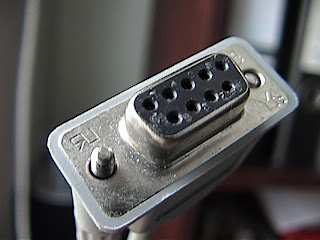In telecommunications, RS-232 is the traditional name for a series of standards for serial binary single-ended data and control signals connecting between a DTE (Data Terminal Equipment) and a DCE (Data Circuit-terminating Equipment). It is commonly used in computer serial ports. The standard defines the electrical characteristics and timing of signals, the meaning of signals, and the physical size and pin out of connectors. The current version of the standard is TIA-232-F Interface Between Data Terminal Equipment and Data Circuit-Terminating Equipment Employing Serial Binary Data Interchange, issued in 1997.
An RS-232 port was once a standard feature of a personal computer for connections to modems, printers, mice, data storage, un-interruptible power supplies, and other peripheral devices. However, the limited transmission speed, relatively large voltage swing, and large standard connectors motivated development of the universal serial bus which has displaced RS-232 from most of its peripheral interface roles. Many modern personal computers have no RS-232 ports and must use an external converter to connect to older peripherals. Some RS-232 devices are still found especially in industrial machines or scientific instruments.
RS-232 was first introduced in 1962.[2] The original DTEs were electromechanical teletypewriters, and the original DCEs were (usually) modems. When electronic terminals (smart and dumb) began to be used, they were often designed to be interchangeable with teletypewriters, and so supported RS-232. The C revision of the standard was issued in 1969 in part to accommodate the electrical characteristics of these devices



No comments:
Post a Comment